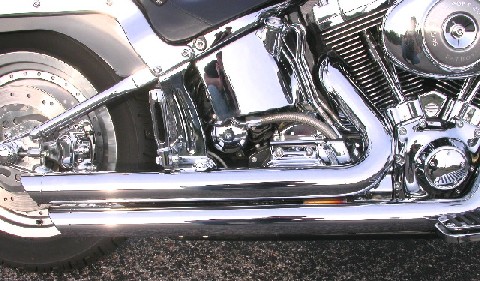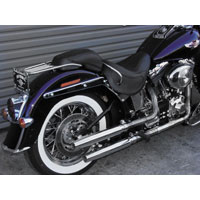Harley exhaust choices vary almost as much as those who ride. Drag pipes, slip-fit mufflers, 2-1, staggered duals, and the list goes on. An exhaust system is made for every bike, engine, style, and configuration imaginable. However, there is a big difference between performance and what looks “cool”. If you are contemplating the purchase of a new Harley exhaust system you should first ask yourself a few questions.
- How important is performance compared to looks?
- Are you looking for performance in low to midrange or high end torque?
- Is your idea of “Hi-Performance” a Cable TV show theme bike?
If you answered yes to #3 then you’re probably going to put whatever looks cool on your bike and not worry about how it runs. For anyone interested in what will improve performance or why those drag pipes made your ride a slug please read on.
Let’s start with the basics. Without getting into a lesson in physics there are three factors that effect the performance and tuning of an exhaust system. Sonic pulse, thermal pulse, and exhaust gas velocity. |
- Sonic pulse. Think of this as a shock wave. This pulse travels through the exhaust and at the end of the pipe actually turns around and heads back toward the exhaust valve. The wave will also pull exhaust gas back along its path and if it reaches the open exhaust valve the gases will dilute the air/fuel mixture in the combustion chamber. Under the right (or wrong) conditions this wave will even push some of the air/fuel mixture back through the intake valve into the intake, a common occurrence with short drag pipes. Torque cones can sometimes reduce this condition.
- Thermal pulse. Similar to sonic pulse, this is a wave created by the hot gas exiting the exhaust valve. The thermal pulse also reverses direction at the end of the pipe but unfortunately travels at a different rate, thus reaching the combustion chamber at a different time.
- Exhaust gas velocity. This is the rate at which gas travels through the exhaust system. The optimal velocity is 300 feet per minute. For the most part all stock Harley engines require a 1-3/4? diameter pipe to maintain 300 fpm. Bigger is not always better and a larger pipe will actually slow this velocity thus restricting flow.
So what does all of this mean? To best answer this question let’s look at a few different exhaust designs and how they handle the above listed conditions.
TIP: Be sure to replace your exhaust port gaskets any time you change or reinstall pipes.
- Short Drag Pipes
Since the sonic and thermal pulses don’t have as far to travel as in a longer system the wave is able to return faster, thus entering the combustion chamber robbing the engine of power. Drag pipes are tuned for higher rpm large displacement engines where these pulses can be overcome. Some drag pipe makers such as Cycle Shack offer special baffles to help tune their drag pipes.

The exception would be the baffled drag pipes offered by Vance & Hines and Hooker similar to the Big Radius pipes and Hooker Troublemakers pictured below. There are also the longer Drag Pipes which have the look of straight drags but the baffles and extra length help compensate for reversion by providing just the right amount of back pressure.

One trick is to install anti-reversion or torque cones. When installed inside the head pipes these cones act to repel the pulse waves as they return to the engine and alter velocity as the gas passes through the narrower passage. Performance will still suffer on the lower end since there is no ability to scavenge gases as with a 2-1 or stock Harley exhaust.
- Large Diameter Open Pipes
While not plagued with the same problems as short drag pipes, a large diameter open pipe will actually restrict flow since the optimal 300 fpm cannot be achieved. The alternative is to install large diameter stepped pipes such as those from Python³ and Samson . Installing larger baffles or thunder tubes will change the velocity. Another remedy is to install a large flat washer toward the end of the pipe body. This requires drilling through the muffler or pipe and welding a washer to the end or a bolt. The washer is then held in suspension in the path of the exhaust, acting as a deflector to adjust the velocity.
- Long Straight Pipes
Running long pipes without any baffles fall under the same category as Large/Open Pipes. Removing the baffle will make these pipes real loud but horsepower will suffer. Remember, bigger isn’t better when it comes to diameter so stick with 1-3/4? head pipes. There are drag pipes incorporating 1-3/4 head pipes and 2 mufflers such as those made by Python³ , Samson , Vance & Hines , Dyno Power, and Hooker . All have excellent offerings in straight pipe designs tuned for standard displacement Harley’s. Python also offers a Staggered Dual system with a hidden cross-over, thus providing some of the benefits of a 2-into-1 exhaust.

- 2 into1
Exhaust systems that use a single collector (2-1) are well tuned for low end torque on stock engines, however they can be restrictive at higher rpm’s. This system’s collector does an excellent job at scavenging gasses and reducing reversion or pulses similar to that of a stock Harley exhaust with a cross-over. The trade off when choosing a 2-1 exhaust is sometimes sound and looks. Some systems include interchangeable baffles to achieve just the right sound and flow. Bub Rinehart, Vance and Hines, White Brothers, Samson, and Thunderheaders are a few of the 2-1 systems that are well made and top performing.

- True Duals
Mostly used on Road Kings and Touring models, “True Duals” have picked up popularity for use on Softails and custom cruisers. The term “Duals” refers to having an exhaust pipe on both sides of the bike. These look especially nice on a Heritage, Nostalgia, or Fatboy for a custom look. Be sure to look for a dual system that incorporates a cross-over for best performance. Duals that do not have a cross-over tend to have rougher idle characteristics or deceleration “pop”. Softail duals can be found from Bub/Rinehart and Samson. Some popular true dual for FL models include V&H Power Duals, Fulsac X Pipes, and Jackpot 2-1-2. These are all technically 2 into 1 into 2 since they have integrated or hidden cross overs.
- Slip-Fit Mufflers
Slip-ons are an excellent choice since you retain your stock Harley exhaust pipes while adding improved performance and sound. Since the original pipes are kept, velocity and lower end torque is retained. Slip-fit mufflers increase flow compared to factory mufflers which are restrictive because of government regulations or sound restrictions. Screamin’ Eagle mufflers have long been very popular, however the newer S.E. II’s are quieter and more restrictive than the older versions. I’ve always liked the mufflers from Rush, Python³, Bub, and Cycle Shack all produce good quality slip-fit mufflers. Vance and Hines make the very popular Oval Slip-On muffler for FL touring models along with a standard performance slip-on.

In conclusion the slip-fit mufflers are often the most economical choice, while longer pipes and 2-1 collectors are the best overall performers in a Harley exhaust system. Drag pipes and large open pipes look and sound “cool” but are definitely tuned for larger engines, thus giving up alot of lower end torque where most daily riders need the power. While the old-school method of punching a hole in your mufflers will produce enough noise from your exhaust to wake the neighbors, this can never compare to a well tuned exhaust system.
When installing a new exhaust system don’t forget to use a fresh set of exhaust gaskets, and finish by fine tuning and rejet your carburetor. If your bike is an EFI model you will need to have it remapped to compensate for the free-breathing exhaust. The most common aftermarket tuner for fuel injection is the Power Commander.
Thanks for stopping by and as always…
Enjoy the Ride! |





